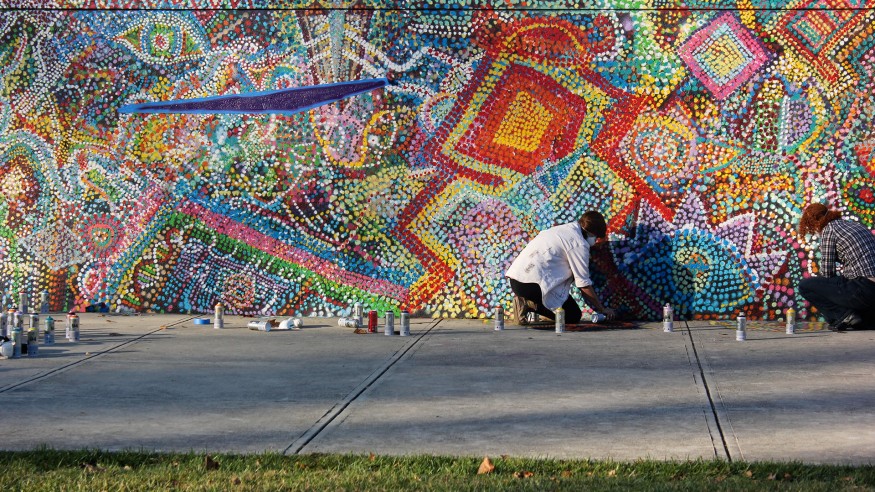
A Meaningful Mural
Ohio Wesleyan’s new mural uses a beadwork concept that student Kerrigan Boyd describes as ‘particularly beautiful and meaningful as it presents the idea that each individual dot is unique and stands alone, but then they unite to create something even bigger and more beautiful.’ (Photo by Karson Stevenson ’16)
Over the course of three days, more than 200 Ohio Wesleyan University students, faculty, and staff came together during Homecoming Weekend to create a new mural that celebrates cultural diversity, acceptance, and social justice.
Located just outside the Hamilton-Williams Campus Center, the mural transforms the once often unnoticed concrete amphitheater area into a whirlwind of bright colors and intricate designs. The project was spearheaded by OWU students Kerrigan Boyd and Catie Beach, who lead the Citizens of the World House and Student Led Art Movement (SLAM), respectively, and worked with their members and other groups to envision and create the mural.
“To me, this is what I treasure most about my experience at OWU and what I hope to carry with me into the world beyond OWU,” Boyd said of the experience. “I think it gets at the heart of what we try to achieve through Small Living Units, Travel-Learning Courses, and Theory-to-Practice Grants. All of these challenge us to engage in celebrating diversity, learn about other cultures and places, and, through that learning process, to find ways to make the world a better and more just place. We wanted to have a piece of art on campus that embodies that pursuit.”
The OWU artists had help creating the mural’s design from Jaque Fragua, a 29-year-old acclaimed multimedia artist from New Mexico. Fragua was selected as the artist for the project after the Citizens of the World House brought him to campus last year. Fragua describes his art as a form of activism linked to a Native American Rights organization called Honor the Treaties.
For Ohio Wesleyan’s mural, Beach and Boyd set up an ideas board where members of the campus community were invited to contribute patterns, symbols, or images meaningful to them. Fragua interpreted these ideas and created an inclusive, cohesive artwork by using a pointillist design approach. This idea is based loosely on beadwork, which is used in many indigenous cultures.
Boyd said the beadwork concept is “particularly beautiful and meaningful as it presents the idea that each individual dot is unique and stands alone, but then they unite to create something even bigger and more beautiful as a whole … like a metaphor for what we aspire to live and learn at OWU and really in the world.”
Boyd said she was inspired to help create OWU’s new mural, in part, by her participation in a Travel-Learning Course to Chiapas, Mexico, with philosophy professor Shari Stone-Mediatore. The course explored the life of the Zapatistas, who have claimed autonomy from the Mexican state to create a society more sensitive to indigenous peoples. While in Mexico, the students and faculty created another mural.
Now that the OWU mural is complete, there are hopes that other public art projects will begin to appear on campus, continuing the momentum.
The students said they appreciate everyone who contributed to the project, with special thanks to faculty members Jim Krehbiel of the fine arts department, Paul Dean of the sociology-anthropology department, and Karen Poremski of the English department. The students also wished to thank Sally Leber, director of Community Service Learning, and Craig Ullom, vice president for Student Affairs.
“It was a big undertaking, and we were able to do it because of persistence and because the community came together,” Boyd said. “I also learned about the power of reaching out. I have said this many times, but I really mean it – we could not have done this without the help of everyone involved (the faculty, the administration, the artist, and the students).”
Poremski downplayed her involvement, but said she was excited to see the creation of the mural bring so many people together during the three days of painting.
“This project became so much more than a painting even though that painting, in and of itself, is a beautiful, wonderful addition to our campus,” Poremski said.
Photos from the Mural-Painting Project
(Photos by Lisa Digiacomo, Taimur Elahi ’15, Spenser Hickey ’15, Karson Stevenson ’16, and Paul Vernon)
